Archive for June, 2009
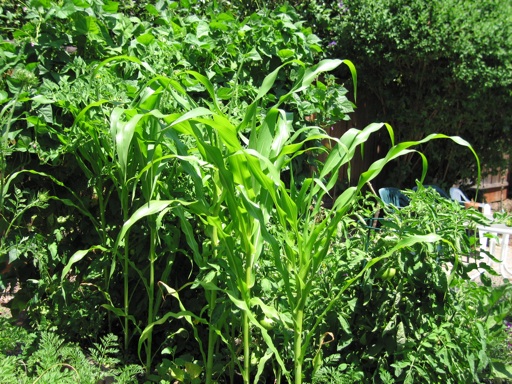
I planted the corn in this picture back in mid-April when it was about two inches high. Corn has been one of the fastest growing plants in our raised bed vegetable garden this year. It has grown particularly fast in the past month. It is already about four feet tall, even though it’s getting crowded by nearby tomato and bean plants that I planted the corn too close to. The fastest growing plants in our garden this year have been pole beans (behind the corn in the picture), corn, tomatoes, and zucchini.
I planted a sweet white variety of corn this year. I tend to prefer the white corn varieties over the yellow corn varieties, because I have found that white corn is usually sweeter. Last year, I grew a bi-colored yellow and white corn variety which turned out to be very flavorful and buttery.
Our tomatoes and beans are also growing vigorously and crowding our nearby peppers and eggplants. The peppers and eggplants haven’t been growing very much. I think that’s because they are not getting enough sun. Perhaps, they don’t have enough root space either. I really underestimated how large some of these fruit/vegetables would get. Next year, I will try to have more restraint by setting out fewer plants.
June 28 2009 | Corn | Comments Off on Fast Growing Corn
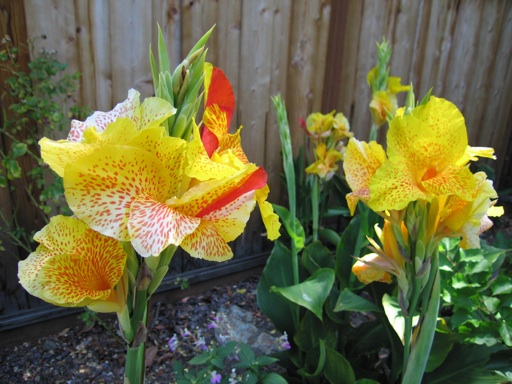
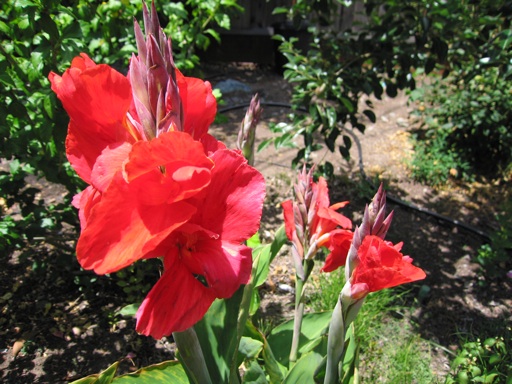
The cannas I planted in our yard a few years ago are flowering again. We are growing red, yellow, and orange cannas. It’s nice to have perennial flowers like cannas in the garden that don’t need to be replanted every year.
Our cannas have grown back year after year with relatively little care. Cannas need watering every few days during our dry season, when I water them with our automatic micro-spray watering system. They also need to be cut to the ground in the fall after bloom. Although, I haven’t ever fertilized them.
Cannas tend to multiply over time by producing new rhizomes. Although, our cannas haven’t spread very fast, and they haven’t been invasive. One can dig up the rhizomes and separate them every few years. The yellow spotted cannas in the first picture above were given to us by a friend who had too many of them.
In our climate where the soil never freezes, I leave our canna rhizomes in the ground over the winter. They survive our occasional frosts and dips into the 20s F without any damage. However, I have been told that in climates that have much colder winters, the top several inches of soil freezes. In these climates, cannas need to be dug up and stored inside in the winter or planted next to a building where they won’t freeze.
June 28 2009 | Cannas | Comments Off on Cannas Are Back
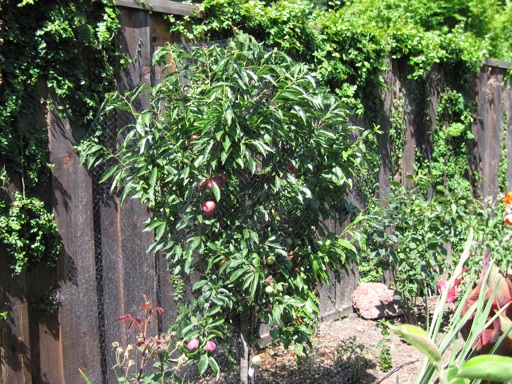
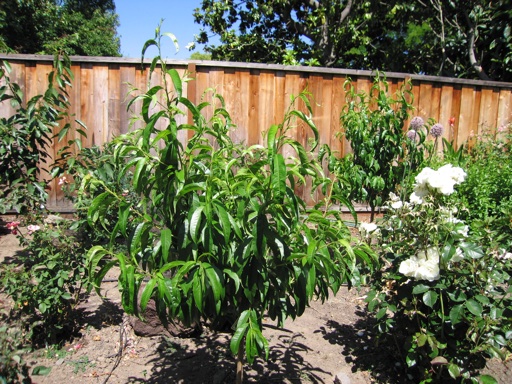
I planted several new fruit trees earlier this year in our yard, including an almond, another peach, a nectarine, a plum, and 2 more cherries. I sometimes hear people say that fruit trees take too many years to produce fruit. For them, I have three words: plums, peaches, and nectarines. All three typically bear fruit by their second year in the ground.
I planted a 4 variety multi-grafted plum tree in February. It already has dozens of plums (see first picture above). Most of the plums are hidden behind the leaves in this picture. The 4 varieties are beauty, nubiana, laroda, and elephant heart. They ripen in June, July, August, and September, respectively, for a 4 four month long plum season. I have already eaten several of the beauty plums, and they are good, with just a little tartness in the skin. Plums produce fruit at a young age. Although my tree wasn’t a new bare root tree when I bought it. It looked like it had been in a pot at least a year.
The other new fruit trees I planted as bare root trees. They don’t have any fruit this year, but they are growing vigorously. The second picture shows the new nectarine (snow queen) in the foreground and the new peach (snow beauty) in the back right. The peach and nectarine trees will likely have their first crop of fruit next summer. Peaches and nectarines produce fruit on branches that grew during the previous year. They also produce fruit at an early age like plums.
I found that one of the keys to growing fruit trees successfully is giving them a regular supply of water and not letting their root systems dry out at any time. In our dry climate, that means regular watering. I have micro-spray devices on all of our fruit trees that are controlled by an automatic watering system. They get watered for about 5 minutes every other day through the spring and summer months. I have found that this schedule keeps the roots moist without over-watering during normal conditions here. During hot weather (90 degrees plus), I water them everyday and/or for a longer time.
Some people are lucky enough to live in climates that get rain on and off throughout the spring and summer months. Last month, I visited family in Kentucky. The small fruit orchard in their backyard includes two peach trees. One of the things I noticed was that the leaves of their peach trees were a pale green color, and they were not actively growing new leaves. The leaves were not a healthy looking deep green like the leaves of our peach trees in California.
My first thought was that they looked like they were not getting enough water. The ground around the trees looked dried out. That seemed strange, because I was told that it had rained a lot in early May before we arrived. Apparently, the sun dries out the ground quickly there too in the late spring.
I have noticed that when fruit trees like peaches don’t get enough water for several days or weeks, the leaves tend to turn pale, and they stop growing. I think that it begins to happen as soon as the roots dry out, which probably happens a lot sooner in young trees that have small roots systems. The lesson I have taken from my experiences is that it is important to prevent the root systems of young fruit trees from drying out, so that they continue to grow through the spring and summer. That’s particularly important for newly planted trees.
Even in Kentucky were it rains frequently through the spring and summer, it’s possible that peaches and other fruit trees can dry out after a week or more without a significant downpour. I was told that nobody bothers to water their outdoor plants in Kentucky, because they feel that there is no need to. But perhaps they should consider supplemental watering during dry spells.
June 21 2009 | Cherries and Peaches/Nectarines and Plums | Comments Off on New Fruit Trees
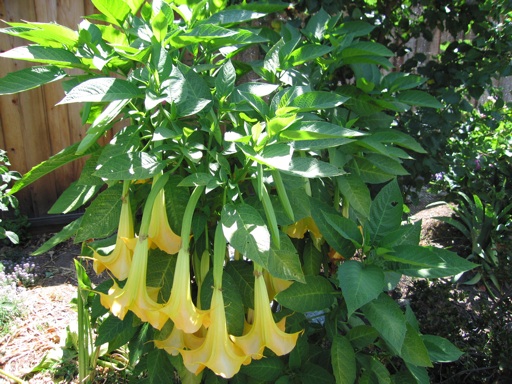
A few years ago, we had a large Charles Grimaldi brugmansia growing in our yard. Every few months, it was full of hundreds of fragrant yellow flowers. Then, in January 2007, we had a hard freeze. The temperature fell into the 20s F for several nights, and our brugmansia died to the ground. Here’s what it used to look like: 7/14/08 Brugmansia post.
Some of the roots survived, but it didn’t grow back right away. Several months later, the roots started to generate a few new shoots. After surviving yet another freezing night in the 20s last January, those shoots have now grown to about four feet tall and are blooming for the first time. It’s great to have it back again. When the sun goes down, we open our kitchen window, and we can smell the flowers inside our house. The flowers have a very unique tropical fragrance. This time I won’t let it grow too large, so that it will be easier to cover during freezing weather.
June 21 2009 | Brugmansia | Comments Off on Brugmansia is Back
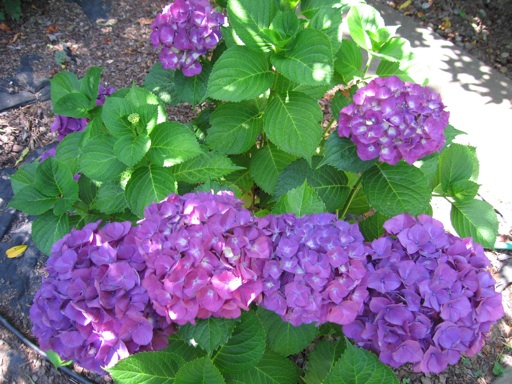
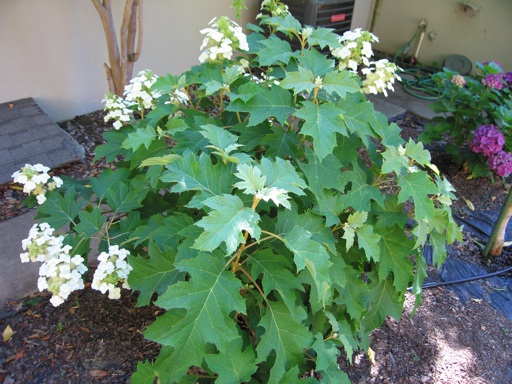
The hydrangeas in our yard are blooming this month. I have always loved hydrangeas, especially the ones that have blue flowers. For the past few years, we have attempted to get our pink bigleaf hydrangeas to turn blue by feeding them aluminum sulfate. We have not been successful. But after a few applications of the aluminum sulfate this spring, the hydrangea in the first picture now has deep purple flowers. Last year, it had pink flowers.
We did not apply aluminum sulfate to two of our hydrangeas. Their flowers were lavender colored last year. This year, their flowers are a light pink color. It seems that without the aluminum, blue or lavender bigleaf hydrangea flowers tend to fade to pink over the years.
We also have three oakleaf hydrangeas. The second picture shows our oldest oakleaf hydrangea with its white flowers. I like oakleaf hydrangeas. They don’t need as much water as the bigleaf varieties, and they usually don’t wilt in hot weather. The flowers of the oakleaves are not as spectacular as the bigleaves, but the oakleaves do have beautiful leaves that often turn red in the fall before falling off. Also, oakleaf hydrangeas attract lots of honey bees.
June 21 2009 | Hydrangeas | Comments Off on June Hydrangeas
Next »







